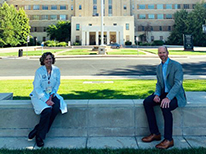Strong Ties Set Stage for Rapid COVID Response
Clinical Affairs | CU School of Medicine Jun 29, 2020
With collaborative working relationships already in place, University of Colorado Hospital (UCH) and Children’s Hospital Colorado (CHCO) came together quickly to create contingency plans for a surge of patients due to COVID-19.
As the pandemic unfolded in other regions of the U.S., it became clear that older adults would be affected in higher numbers and with more serious health problems than children. With only days to weeks to plan for a rapid increase in patient population at UCH, leadership at both UCH and CHCO set up daily planning meetings to explore how CHCO could offer support if the patient surge exceeded UCH’s capacity.
Pictured are Drs. Jean Kutner and David Brumbaugh
“We looked at the trends in the rest of the country and what was happening here in Colorado to anticipate how many people we were talking about and what their care needs would be,” said Jean Kutner, MD, MSPH, Chief Medical Officer at UCH and Professor of Medicine. “We had to define the patient population and decide who could and could not go to Children’s if University of Colorado Hospital reached capacity.”
The team looked at which patients CHCO had both the equipment and expertise to treat, given that their focus population is typically people under age 20. While they wanted to make the most of CHCO’s extra capacity, they also wanted to be strategic about staying within the CHCO’s expertise so both institutions could continue to offer the high-quality care they usually offer. Given this strategy, the leadership team decided on several roles for CHCO.
First, they decided that two populations could be directed to CHCO for care: those who are pregnant and young adults who needed treatment for conditions other than COVID-19. CHCO mostly serves pediatric patients; this sometimes includes people in the higher end of that age range (ages 18–21), especially for complex and chronic health conditions. The team recognized that young adults in their 20s were physiologically similar to this patient population and could safely be treated at CHCO if needed.
CHCO also has existing capacity for labor and delivery, though its focus is usually on high-risk deliveries in which the baby would likely require immediate care after birth. The two hospitals had an existing strong relationship between maternal/fetal medicine to draw on, making this a logical extension of services for CHCO. The hospitals worked together to ensure that CHCO would have the type of staff, equipment, protocols and systems needed for healthy births in case UCH needed to divert labor and delivery patients.
In addition to serving these additional populations, CHCO prepared to share equipment with UCH, administer COVID-19 testing and provide convalescent plasma for treating critically ill adults. CHCO did an inventory of its supply of ventilators and allocated some of their inventory to be used by UCH if needed. It also stepped up to increase its daily COVID-19 diagnostic testing at one point, when it had greater capacity to do these tests.
While these steps might seem logical and simple, there is quite a bit of work that goes into ensuring safety, aligning protocols and ensuring that systems can handle the new record-keeping and billing.
“A number of people deserve credit for making this happen,” said David Brumbaugh, MD
Associate Chief Medical Officer at CHCO and Associate Professor of Pediatrics. “They handled so many details, like adjusting EHRs, arranging for equipment moves, ensuring proper credentialing for UCH nurses to work at CHCO, developing protocols for triage and treatment and more. It was done in a short time with strong support of leadership and commitment from staff at all levels.”
Although the contingency plans for a patient surge have not yet been needed, it remains ready for use when the need arises. Staff from both hospitals are proud of the work they were able to do so quickly to create a responsive and smart plan for making the best use of the resources on the Anschutz campus.
Dr. Kutner said that the success was due to existing relationships between the two institutions, cultivated and facilitated over time by the School of Medicine. “We’ve got a long history of working together. Our guiding light has always been what is best for the patient. As long as we start with that common goal and proceed with an open mind and creativity, we can work through just about anything to get to a solution.”